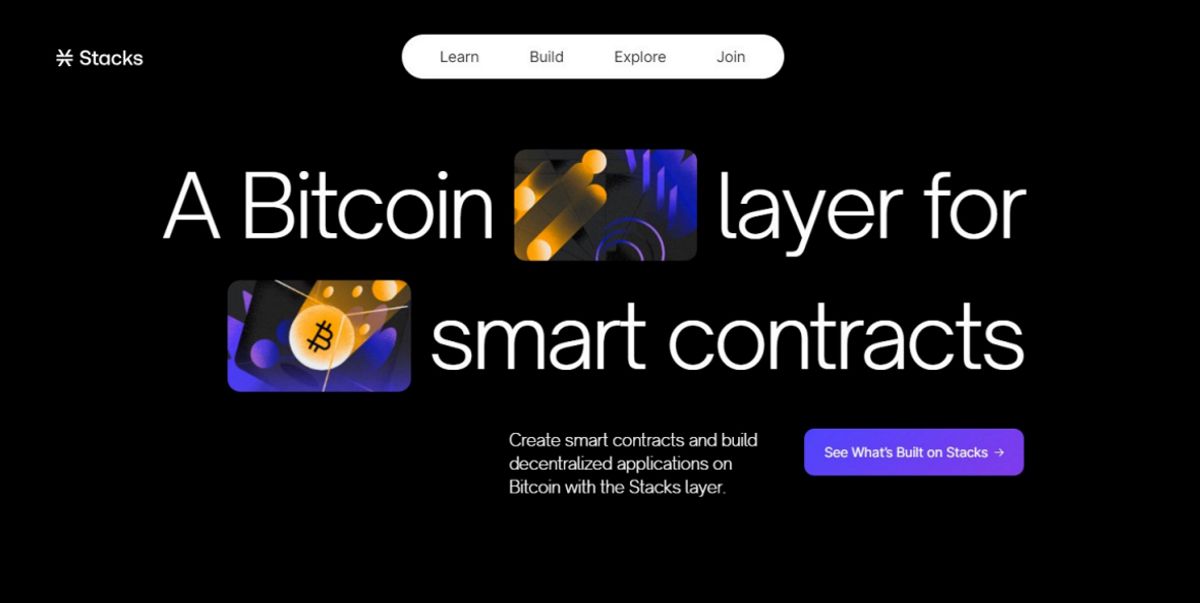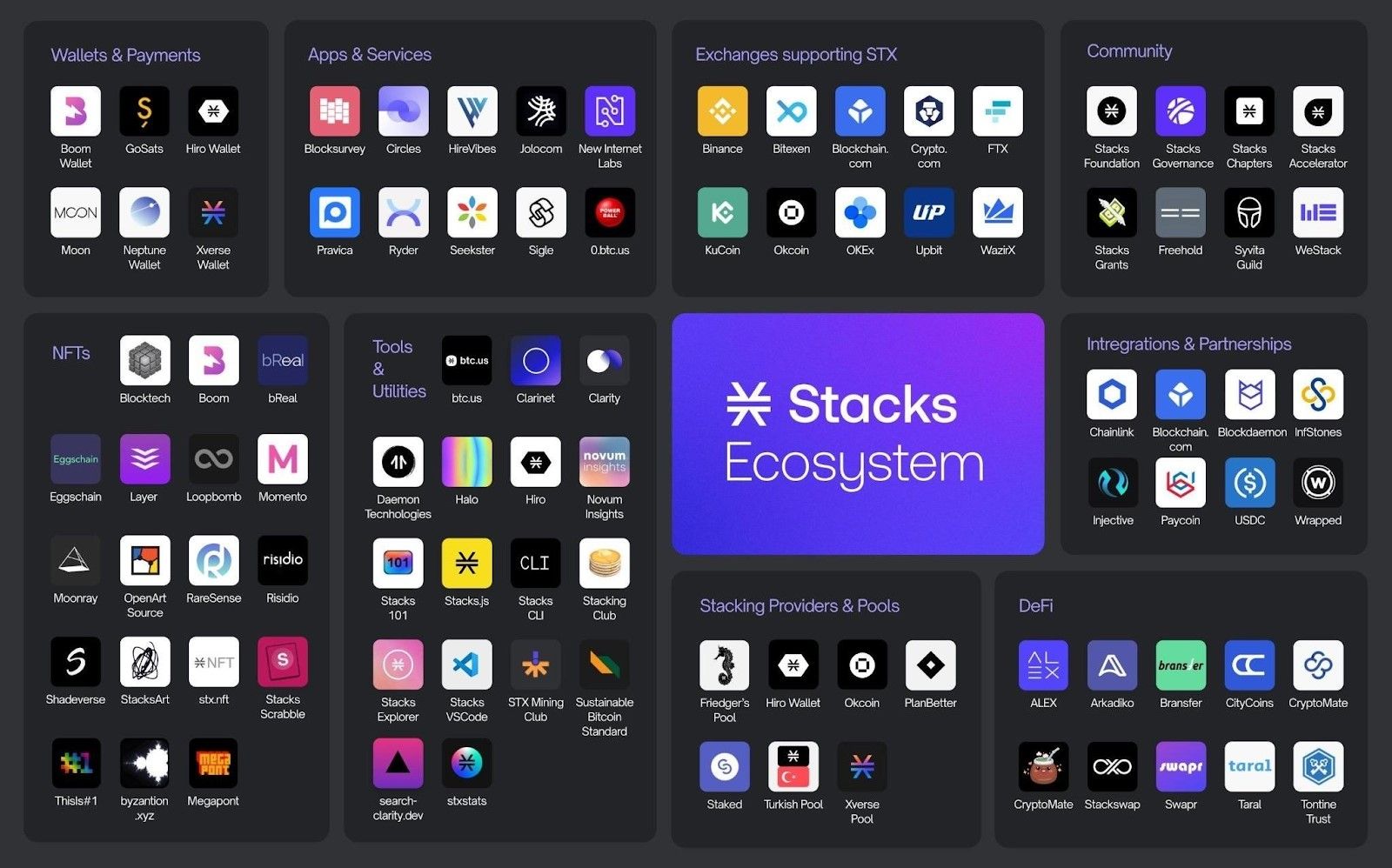The blockchain trilemma is a persistent problem in the world of cryptocurrencies. Even Bitcoin, considered the pinnacle of decentralization and security, grapples with this issue. While it has established the benchmark for all crypto ventures in the market, its scalability limitations make the BTC blockchain impractical for Web3-based applications.
Stacks is a platform that seeks to address this predicament by introducing a layer to Bitcoin, offering a potential solution. So, what exactly is Stacks, and how does it operate?
What Is Stacks?
Before delving into Stacks, let’s explore the distinctions between Layer 1 and Layer 2 blockchains. Layer 1 blockchains, such as Bitcoin or Ethereum, serve as primary blockchains. While these blockchains offer robust security and decentralization, their limited scaling capabilities result in low throughput, creating a blockchain trilemma.
As such, Layer 2 blockchains have emerged as a solution to enhance the scalability and efficiency of Layer 1 networks. These blockchains function as an additional layer atop the main blockchains, facilitating transactions. For example, Ethereum is a Layer 1 blockchain, and Polygon provides Layer 2 solutions. However, Layer 2 solutions for Bitcoin are less prevalent than Ethereum ones.
Stacks is among the platforms that have introduced a layering protocol for the Bitcoin blockchain. It shares similarities with Layer 2 solutions, but the key distinction lies in its utilization of BTC as an anchor while operating alongside it. By doing so, Stacks enables the integration of smart contracts into the BTC blockchain, opening avenues for decentralized applications (DApps) on the network. Stacks tokens (STX) bolster the network’s security and leverage Bitcoin’s security features.
Initially known as Blockstack, the Stacks platform was launched with its genesis block in 2018. It rebranded as Stacks in 2020 and launched its mainnet in 2021.
How Does Stacks Work?
The Stacks blockchain operates using the Proof of Transfer (PoX) consensus mechanism, which enables it to connect with the Bitcoin network. The PoX mechanism is derived from Proof of Burn (PoB), where miners add blocks to the chain by burning their tokens to receive rewards from the network.
PoX operates similarly, but instead of burning crypto coins, it validates blocks through token transfers. Participants in the validation process of the L2 blockchain transfer their tokens to another participant’s address. These transactions occur within the L1 network using the L1 native tokens.
In this approach, transactions play a crucial role in verifying new blocks. The L2 blockchains are designed to read the state of the L1 network every 24 hours and verify all transactions among L2 participants. As part of this process, all L2 participants receive incentives for contributing to L2 native tokens.
Understanding the Stacks Consensus Mechanism
On the Stacks network, the PoX consensus algorithm leverages the proof of work (PoW) mechanism of Bitcoin to secure the network. Essentially, it repurposes PoW so that each block on Stacks can be verified on the Bitcoin network. This mechanism, known as the “Trust-minimized Bitcoin peg,” establishes a 1:1 connection between Bitcoin and Stacks.
The PoX mechanism involves two primary groups: miners and stackers. Miners are responsible for mining Bitcoin on the Bitcoin network and validating it for Stacks using their mining fees. This enables them to win a new block, but before doing so, they must send the Bitcoin to another stacker. The protocol randomly selects a BTC receiver, and a new Stacks block is formed using the complete hashing power of Bitcoin.
The Stacks protocol verifies these transactions by reading the state of the Bitcoin network. Its smart contract allows Stacks to access the Bitcoin network state after every 100 blocks have been confirmed. However, it cannot directly modify the state of the Bitcoin network. The protocol randomly selects a miner and rewards them with STX tokens.
Rewarding System on Stacks
The PoX rewarding system resembles the proof of stake (PoS) mechanism. However, the rewards are based on the locking of STX tokens and the transfer of BTC. Miners receive STX rewards for mining a block, while stackers receive BTC for locking their STX tokens.
It is important to distinguish between Stacking and staking. Crypto staking is widely utilized in various proof of stake mechanisms. It involves locking a specific quantity of tokens, which are subsequently used for transaction validation on the blockchain. On the other hand, stacking is a process where Stacks validators send BTC (Bitcoin) to other validators to facilitate the addition of a block to the chain.
Stacks vs. Ethereum
The increasing demand for blockchain and cryptocurrencies has led to the development of various scalable solutions in the market. Numerous projects have emerged intending to enhance the efficiency of Layer 1 blockchains.
While many of these projects depend on the Ethereum network, which is well-known for its smart contracts, it’s worth examining Stacks vs. Ethereum to assess the features of this Bitcoin DeFi platform.
1. Consensus Mechanism
Consensus mechanisms are vital in ensuring a blockchain’s security, decentralization, and scalability.
Stacks utilizes the proof of transfer consensus mechanism. It leverages the proof of work mechanism of the Bitcoin network for security. Every transaction on the Stacks blockchain is validated through the Bitcoin network. Anyone can track STX transactions on the BTC blockchain, ensuring the blockchain’s security and decentralization.
On the other hand, Ethereum transitioned from a proof of work to a proof of stake mechanism during the 2022 Ethereum Merge. This shift has significantly improved the efficiency of the Ethereum network. Additionally, Ethereum, a widely trusted network for smart contracts, has a strong community of participants who stake their ETH tokens to secure the network.
2. Security and Efficiency
The security of Stacks relies entirely on the BTC blockchain, which serves as an anchor for its operations. In its relatively short history, the blockchain has not experienced any significant security breaches, highlighting the practicality of its secure ecosystem.
Additionally, Stacks employs various techniques to enhance its efficiency. While the time required to add blocks on Stacks is comparable to the BTC blockchain, it utilizes micro blocks to process transactions. It also leverages subnets (formerly hyperchains) to increase overall throughput. This allows Stacks to maintain efficiency while benefiting from BTC’s robust security.
When it comes to Ethereum, it also boasts a strong reputation for security. It is the largest protocol and enjoys the trust of developers worldwide. Although Ethereum’s native throughput is around 20 to 30 transactions per second (TPS), it can be optimized using various scaling solutions. Consequently, users can utilize the Ethereum network without being restricted by security or efficiency concerns.
3. Network Ecosystem
BTC is often considered a passive asset with limited utility beyond cryptocurrencies. However, Stacks is introducing a unique ecosystem that enhances the usability of Bitcoin. It offers a comprehensive DeFi Bitcoin platform where users can collect and mint BTC-based non-fungible tokens (NFTs) and participate in decentralized autonomous organizations (DAOs) and other Web3-based decentralized applications (DApps).
You will find various platforms within the Stacks ecosystem, such as Gamma, Stacksbridge, LNSwap, and LydianDAO. Despite being a relatively young project, Stacks has the potential to invigorate the DeFi landscape by incorporating the security and decentralization of Bitcoin.
Nevertheless, Stacks faces a significant challenge in competing with the Ethereum network. Launched in 2015, Ethereum has evolved into a robust network hosting many DApps. According to a report by CryptoPotato, over 44 million smart contracts have been deployed on the Ethereum chain since its inception, highlighting its dominant position in the industry. Despite the emergence of several Ethereum competitors like Solana during this period, none has managed to surpass Ethereum’s success so far.
4. Tools for Developers
Ethereum is renowned for being one of the most developer-friendly platforms. This is largely attributed to the Ethereum Virtual Machine (EVM), which enables developers to run smart contracts. Furthermore, the Solidity programming language has gained popularity as a preferred choice for writing Web3 application code.
In comparison, Stacks offers a range of supportive tools for development. The platform provides numerous learning resources and tools to assist developers. Alongside its smart contract language, Clarity, Stacks offers an interpreted language that is relatively easier for developers to learn. Moreover, Clarity being Turing incomplete helps eliminate unnecessary complexities, making it a more efficient and secure language for executing smart contracts.
Stacks Offers a DeFi Bitcoin Platform
Stacks stands out as one of the few projects that have ventured into creating a DeFi Bitcoin platform amidst a sea of scaling projects focused on Ethereum. By harnessing the security and decentralization of Bitcoin, Stacks aims to address the blockchain trilemma.
The platform offers a comprehensive DeFi Bitcoin ecosystem that enhances the usability of Bitcoin for Web3 applications, allowing the creation of Bitcoin-based decentralized autonomous organizations, decentralized applications, and even Bitcoin Ordinal marketplaces. However, it is important to note that Stacks is still in its developmental stage, and its ability to compete with Ethereum in the future remains to be seen.







